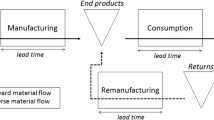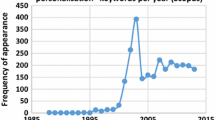Abstract
Much of the literature on forward supply chain management has focused on the importance of product design. In this research, we follow this approach and apply it to manufacturing systems in a closed-loop supply chain. We consider two closed-loop manufacturing structures: parallel and mixed structures. In the parallel structure, the assembly and disassembly are performed by separate lines, whereas in the mixed structure, they are performed by the same production line. We study effect of the use of a common component, the location of a common component, and the degree of delayed differentiation on the mean and variance of the cycle time for assembly (CTA). We find that the use of a common component significantly reduces the mean and variance of the CTA. The effect is pronounced when the variation in the disassembly service time is high, the structure is parallel, the utilization rate is high, the new-parts inventory level is low, and/or the return rate is high. Furthermore, placing the common component at the center of the manufacturing system yields the lowest mean and variance of the CTA. However, the effect is not statistically significant. Although increasing the degree of delayed differentiation significantly reduces the mean and variance of the CTA, the effectiveness is very sensitive to the process parameters.
Similar content being viewed by others
References
Baker K. R., Magazine M. J., Nuttle H. L. W. (1986) The effect of commonality on safety stock in a simple inventory model. Management Science 32(8): 982–988
Bowersox D. J., Closs D. C. (1996) Logistical management: The integrated supply chain process. The McGraw-Hill Companies, New York
Chung C. J., Wee H. M. (2008) Green-component life-cycle value on design and reverse manufacturing in semi-closed supply chain. International Journal of Production Economics 113: 528–545
Chow W. M. (1987) Buffer capacity analysis for sequential production lines with variable process times. International Journal of Production Research 25: 1183–1196
Collier D. A. (1982) Aggregate safety stock levels and component part commonality. Management Science 28(11): 1296–1303
Conway R., Maxwell W., McClain J. O. (1998) The role of work-in-process inventory in serial production lines. Operations Research 36(2): 229–241
DeCroix G. A., Zipkin P. H. (2005) Inventory management for an assembly system with product or component returns. Management Science 51(8): 1250–1256
Desai P., Kekre S., Radhakrishnan S., Srinivasan K. (2001) Product differentiation and commonality in design: Balancing revenue and cost drivers. Management Science 47: 37–51
Eynan A., Rosenblatt M. J. (1996) Component commonality effects on inventory costs. IIE Transactions 28: 93–104
Farrell R. S., Simpson T. W. (2003) Product platform design to improve commonality in custom products. Journal of Intelligent Manufacturing 14: 541–556
Gerchak Y., Magazine M. J., Gamble A. B. (1988) Component commonality with service level requirements. Management Science 34(6): 753–760
Guide V. D. R. Jr., Srivasta R. (1998) Inventory buffers in recov- erable manufacturing. Journal of Operations Managements 16: 551–568
Guide V. D. R. Jr., Jayaraman R., Srivasta R. (1999) Production planning and control for remanufacturing. Robotics and Computer-integrated Manufacturing 15(3): 221–230
Guide V. D. R. Jr., Wassenhove L. N. V. (2001) Managing product returns for remanufacturing. Production and Operations Management 10(2): 142–155
Gungor A., Gupta S. M. (1998) Disassembly sequence planning for products with defective parts in product recovery. Computers and Industrial Engineering 35: 161–164
Handfield R., Walton S. V., Sroufe R., Melnyk S. A. (2002) Applying environmental criteria to supplier assessment: Astudy in the application of the analytical hierarchy process. European Journal of Operational Research 141: 70–87
Hill T., Chanbers S. (1991) Flexibility—A manufacturing conundrum. International Journal of Operations and Production Management 11(2): 5–13
Hillier M. S. (1999) Component commonality in a multiple-period inventory model with service level constraints. International J Production Research 37(12): 2665–2683
Humphreys P. K., Wong Y. K., Chan F. T. S. (2003) Integrating environmental criteria into the supplier selection process. Journal of Materials Processing Technology 138: 349–356
Jans R., Degraeve Z., Schepens L. (2008) Analysis of an industrial component commonality problem. European Journal of Operational Research 186: 801–811
Jiao J., Tseng M. M. (1999) A methodology of developing product family architecture for mass customization. Journal of Intelligent Manufacturing 10: 3–20
Ketzenberg M. E., Souza G. C., Guide V. D. R. Jr. (2003) Mixed assembly and disassembly operations for remanufacturing. Production and Operations Management 12(3): 320–335
Kleber R., Minner S., Kiesmüller G. (2002) A continuous time inventory model for a product recovery system with multiple options. International Journal of Production Economics 79: 121–141
Lee H. L., Tang C. S. (1997) Modeling the cost and benefits of delayed product differentiation. Management Science 43(1): 40–53
Li L., Huang G. Q., Newman S. T. (2008) A cooperative coevolutionary algorithm for design of platform-based mass customized products. Journal of Intelligent Manufacturing 19: 507–519
Lieckens K., Vandaele N. (2007) Reverse logistics network design with stochastic lead times. Computers and Operations Research 34: 395–416
Nasr N., Hughson C., Varel E., Bauer R. (1998) State-of-the-art assessment of remanufacturing technology. Rochester Institute of technology, New York
Noci G. (1997) Designing green vendor rating systems for the assessment of a supplier’s environmental performance. European Journal of Purchasing and Supply Management 3(2): 103–114
Oh Y. H., Hwang H. (2006) Deterministic inventory model for recycling system. Journal of Intelligent Manufacturing 17: 423–428
Olson, D. (2001). Special Customer Operations. Lucent Technologies, Private communication with the authors.
Pagh J. D., Cooper M. C. (1998) Supply chain postponement and speculation strategies: How to choose the right strategy. Journal of Business Logistics 19(2): 13–33
Savaskan R. C., Bhattacharya S., Wassenhove L. N. V. (2004) Closed-loop supply chain models with product remanufacturing. Management Science 50(2): 239–252
Su J. C., Chang Y. L., Ferguson M. (2005) Evaluation of postponement structures to accommodate mass customization. Journal of Operations Management 23: 305–318
Suh E. S., Weck O. D., Kim I. Y. (2007) Flexible platform component design under uncertainty. Journal of Intelligent Manufacturing 18: 115–126
Swift K. G., Booker J. D., Edmondson N. F. (2004) Strategies and case studies in assembly system selection. Institution of Mechanical Engineers 218(B): 675–688
Tani K., Guner E. (1997) Concept of an autonomous disassembly system using behavior based robotics. Production and Operations Management 11: 187–198
Zikopoulos C., Tagaras G. (2007) Impact of uncertainty in the quality of returns on the profitability of a single-period refurbishing operation. European Journal of Operational Research 182(1): 205–225
Zikopoulos C., Tagaras G. (2008) On the attractiveness of sorting before disassembly in remanufacturing. IIE Transactions 40(3): 313–323
Zinn W., Bowersox D. J. (1998) Planning physical distribution with the principle of postponement. Journal of Business Logistics 9(2): 117–136
Author information
Authors and Affiliations
Corresponding author
Rights and permissions
About this article
Cite this article
Su, J.C.P., Lin, Y.C. & Lee, V. Component commonality in closed-loop manufacturing systems. J Intell Manuf 23, 2383–2396 (2012). https://doi.org/10.1007/s10845-010-0485-1
Received:
Accepted:
Published:
Issue Date:
DOI: https://doi.org/10.1007/s10845-010-0485-1




